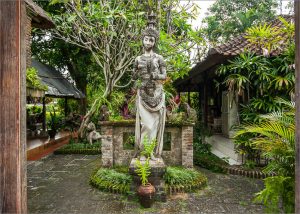Phosop is the rice deity of the ancient Thai religion, and is one of many rice goddesses in eastern cultures. While honouring her is still practiced today, she is predominantly an ancient deity rather than a part of the structured mainstream religion. As such, her worship is now mainly relegated to rice growing villages. Phosop is also known as ‘Mae Khwan Khao’ which translates to ‘Mother of Rice Prosperity’.
Ritual offerings are traditionally made to placate a rice deity during each stage of rice production. Phosop in particular was believed to be responsible for ensuring each person had enough food. Queen Sirikit gave this ancient Thai traditional her royal patronage in August 2008. This is evidence that while ancient, her existence is still at the forefront of the culture during these periods of cultivation and harvest. Both Thailand and Cambodia still celebrate a ‘Royal Ploughing Ceremony’. This is where sacred oxen are attached to a ceremonial wooden plough, and they plough the ceremonial ground. Following this, the oxen are offered multiple plates of food and predictions of the harvest are made on what is eaten. Local people collect the seeds from the furrows following this ceremony in order to increase their own luck in the coming year. While Phosop is not a part of the modern Thai religion, these festivals in her honour relating to rice and each of its cultivation stages have a deep traditional significance. A failure to honour these would jeopardise the luck of the farmers to have a bountiful harvest.
Phosop is usually represented as a beautiful woman who wears a full set of traditional jewellery. She is often shown in either a red or green traditional dress in order to represent the fertility of the harvest. She is usually depicted seated or standing, and holds a rice sheaf across either her right shoulder or resting against her right arm. The origins of her imagery are based on local and ancient customs. However, the modern iconography of Phosop is now commonly based on a ‘Devī’ goddess of Hinduism. In smaller regional areas that still celebrate a festival in her honour, a young woman from a village may dress as Phosop in order to represent the goddess in all celebrations.
Thailand is not the only country that worships a rice deity. Laos also worships a rice goddess known as ‘Nang Khosop’. According to a manuscript housed in the Wat Si Saket Buddhist temple, there was a thousand-year famine which ended when a young man caught a fish. A sea deity heard the fishes cry and bargained with the man to exchange its life for some treasure; the maiden Nang Khosop, who was the soul of the rice. It was believed that while she lived in the fields of Laos, rice would nourish humans for many centuries. A nearby king became greedy and began to hoard the rice for his own enjoyment, angering Nang Khosop and causing her to bring about a famine. After refusing to reverse the famine, a local hermit from the forest caught and slaughtered her. The pieces of her body are believed to have changed into multiple varieties of rice, which the local communities were taught how to cultivate and grow for themselves.
While rarer than in ancient times, the worship of rice deities to ensure a plentiful harvest is still alive and well in many cultures and countries.
-Devon Allen
Junior Girl
Girl Museum Inc.

